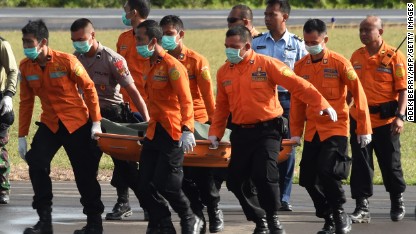
UPDATED: 03:42 PM EST 01.02.15
With
crews from around the world aiding in the search, 30 bodies have been
recovered from the wreckage of AirAsia Flight QZ8501, Indonesian
officials said Friday.
What appears to be a piece of the fuselage was found, Singapore's Defense Ministry said. It resembles a window panel.
Finding
the fuselage and the plane's "black boxes" are a priority, Indonesia's
search and rescue agency said Friday. There are 59 teams of divers
involved, the agency's chief Bambang Sulistyo said, according to the
state-run Antara news agency.
The
USS Sampson, the U.S. Navy ship that is helping with the search,
recovered two of the bodies, the U.S. Seventh Fleet said Friday.
Indonesian
authorities have identified four of the recovered bodies so far. The
first victim they identified, an Indonesian woman named Hayati Lutfiah
Hamid, was buried Thursday. Many family members are waiting in Surabaya
for news about their loved ones.
But with 162 people on the plane when it took off from Surabaya, Indonesia, crews have a long way to go.
AirAsia
CEO Tony Fernandes said he was traveling Friday to Surabaya to bring
the body of flight attendant Khairunisa Haidar Fauzi home.
"I cannot describe how I feel. There are no words," he said on Twitter.
Search
efforts are concentrated in a zone covering 1,575 square nautical miles
(5,400 square kilometers) that officials believe is the "most probable
area" to find the remains of the aircraft.
But on Friday, waves in the Java Sea as high as four meters (13 feet) were making it hard for divers search underwater.
The
weather is "the biggest obstacle," said Bambang Hermanu, chief of
police in Indonesia's Central Kalimantan province, where much of the
search operation is based.
Anguish revisited: Relatives of MH370 victims speak
Here's more key information about where things stand on Flight QZ8501:
The flight
What
we know: The aircraft took off early Sunday from Surabaya, bound for
Singapore. Roughly 35 minutes into the flight, the pilot asked air
traffic control for permission to turn left and climb to avoid bad
weather. Minutes later, the plane disappeared from air traffic control's
radar.
What
we don't know: What happened on board after contact with the plane was
lost. No distress call was received. Indonesian aviation authorities
have suggested that the plane ascended despite permission being denied
because of traffic.
Some
experts have speculated that the aircraft might have experienced an
aerodynamic stall because of a lack of speed or from flying at too sharp
an angle to get enough lift. Analysts have also suggested that the
pilots might not have been getting information from onboard systems
about the plane's position, or that rain or hail from thunderstorms in
the area could have damaged the engines.
Until
the main wreckage of the plane is found, along with the flight
recorders, experts have little evidence to support their theories.
The search
What
we know: Search teams found debris and some bodies 100 to 200
kilometers (about 60 to 120 miles) from the aircraft's last known
location over the Java Sea, Indonesia's search and rescue agency said.
What
we don't know: The exact location of the body of the aircraft. An
Indonesian search official told CNN on Wednesday that he thought sonar
equipment had detected wreckage from Flight 8501 at the bottom of the
Java Sea. But the country's search and rescue chief said the plane
hadn't been found yet. Bad weather has hindered the search operation.
The investigation
What
we know: The key to understanding what happened may be in the
aircraft's cockpit voice recorder and flight data recorder, commonly
known as black boxes. The black boxes, which are actually orange, are in
the tail of Airbus 320-200s. If recovered, they will be taken to a lab
in Jakarta, Indonesia, to be analyzed, said Tatang Kurniadi, head of
Indonesia's National Committee for Transportation Safety. The batteries
powering the "pingers" that send acoustic signals have only about 24
days of power left, officials said.
What
we don't know: Where the plane's remains might have been taken by the
elements. Investigators will need to use information gleaned from the
flight recorders and clues from the wreckage.
"The
more bits I can put into my mosaic, the better my picture will be,"
aviation safety expert Michael Barr said. "The better the picture, the
better I can come up with an understanding of what happened." But the
conditions at sea make that work much more difficult than on land. "In
the water, you are working with currents and winds, and so the pieces
won't be where they had the initial impact," he said.
The plane and the pilots
What
we know: The 6-year-old Airbus A320-200, operated by AirAsia's
Indonesian affiliate, had accumulated around 23,000 flight hours in
about 13,600 flights, according to Airbus. The plane's last scheduled
maintenance was on November 16.
Flight
8501's veteran captain, Iriyanto, 53, had 20,537 flying hours, 6,100 of
them with AirAsia on the Airbus A320, the airline said. The first
officer, Remi Emmanuel Plesel, 46, had 2,275 flying hours, a reasonable
amount for his position.
What
we don't know: Whether technical problems, human error or other issues
were involved in the crash. According to information from the Aviation
Safety Network accident database, there have been 54 incidents involving
the A320.
"In
the A320 family, accidents and incidents range from fan-cowl
detachment, landing gear collapse, bird strikes, right through to hull
losses through pilot error," said Kane Ray, an analyst with the
International Bureau of Aviation, a global aviation consulting group.
"Most aircraft have teething problems, and in most cases, these are
eradicated. Very rarely, these issues cause disasters -- largely because
of a culmination of factors that lead to the event," Ray said.









0 comments:
Post a Comment
ff on Twitter: @TheNaijaInfo
Facebook.com/NaijaInfo
Email: TheNaijaInfo@gmail.com
What do you think about this post?